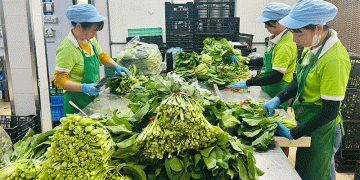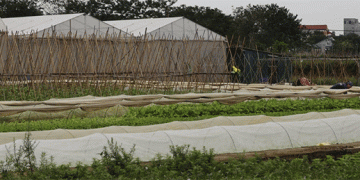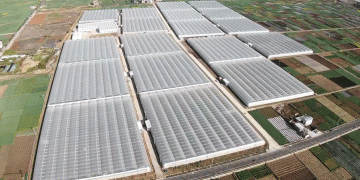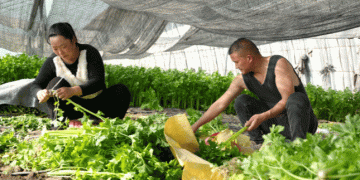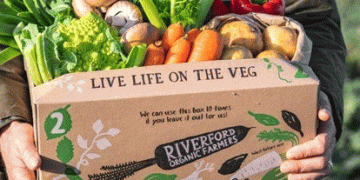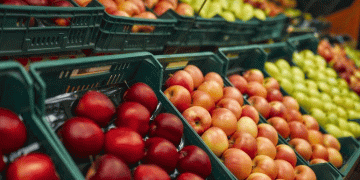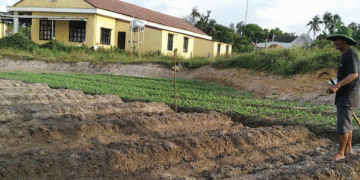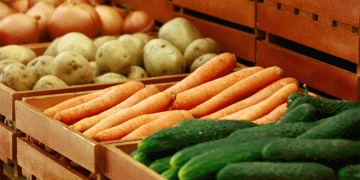Introduction to fast growing vegetables for beginners: Spring, summer, and fall are perfect seasons for succession planting of fast-growing vegetables. Succession planting refers to planting one vegetable after another so that you can produce the most food. In addition, weeds have less space to grow when the gardens are productive. Therefore, the garden’s May and June crops, such as peas and spinach, are followed by fresh sowings of fast-growing plants like bush beans, beets, and summer lettuce. In succession planting, especially as summer transitions to autumn, it is essential to determine if you have enough time to grow and mature the crop for harvest. Two things are necessary in this case: 1) the days until your desired crop has matured; and 2) the number of days until your first frost. Check seed catalogs and seed packets carefully for days to maturity information. You can figure out how many days remain before the first average frost day to confirm you still have time to grow the crop once you know the days to maturity. In a short growing season, you can produce a heavy crop of fast-growing vegetables. Raise beds, containers, or fabric bags work well for growing speedy vegetables. To encourage healthy growth, add compost between successive crops.
A guide to fast growing vegetables in summer, winter, pots, at home, tips, ideas, and techniques
How to start fast growing vegetables: Soak the seeds gently in water after covering them with loose soil. Always keep the soil moist. When the seeds germinate, and the saplings have four true leaves, transplant them into bigger pots. Direct sunlight is needed by plants every day for at least 6-8 hours.
The best ways to fast growing vegetables
Vegetables that grow fast must be chosen carefully. Despite the time and effort you put into your garden. It takes time to grow. We sure would appreciate some tips on how to make our vegetables grow faster. Tricks or tactics aren’t possible, unfortunately. However, the techniques used by generations of gardeners continue to be effective today. High-quality soil is essential to ensuring a healthy and productive garden. During the growing season, some methods, like soil-warming, keep diseases and weeds at bay. You can make sure that your garden continues to flourish all summer long by following some time-tested gardening techniques. Although there is no one-size-fits-all solution to this problem, many successful gardeners follow a few methods that have proven to be reliable over time. To increase the growth rate of your vegetables, you need good soil, soil warming techniques, weed control, and disease control techniques, among other gardening techniques. I have always been fascinated by people who grow vegetable gardens. It seems that some people handle it with such ease as if it were such a simple matter. As I tasted their delicious garden-grown vegetables, I wondered how they managed to achieve their goal. Now we’re ready to look at some time-tested ways to help your vegetables grow faster that have been used by generations of successful gardeners.
Getting the Ground Ready: Prepare the soil well before sowing your fast-growing crops. By doing this, the soil should have enough nutrients to support healthy growth and the right texture to encourage even germination. Preparing the ground is as simple as spraying organic fertilizer and raking it down to a fine tilth.A good-quality, multi-purpose potting soil also is used to grow all of these super-fast vegetables.
Nutrients and soil quality: Vegetables require more nutrients than most plants since they produce large leaves and fruit in just one season. Additionally, rich, well-draining soil produces vigorous growth, which gets you the results you want.Compost or manure at 1/2 to 1-inch depth per year will enhance your garden. Soil gains more nitrogen, and soil drainage is improved so that plants can get sufficient oxygen.To fertilize your garden soil with nitrogen, add 2 pounds of ammonium phosphate for every 100 square feet. Then, when your plants are about four inches tall, you need to side-dress the vegetables with two pounds of ammonium sulfate. This early soil attention will make a significant difference to the growth of your garden.
A sufficient amount of sunlight and warmth: must be provided every day for plants to grow. Temperatures in the soil and air are essential to plant growth and germination. The seeds may rot or not germinate properly and fail to produce fruit in cold soils. As a result, plants grow slowly, and eventually, they may not produce any fruit.Warming up the soil in the spring will be more efficient with raised beds. As well as floating row covers, you can find row covers of different weights that will also raise soil temperatures.
Improved Water Practices: It is impossible to grow faster without a sufficient supply of moisture. If you have a reduced water supply, plants will grow slowly and produce low-quality produce. Rather than overhead sprinklers, consider soaker hoses or a drip system.Using such systems reduces water consumption, and diseases spread by wet leaves are reduced. Consider installing moisture meters that can alert you to the dryness of the soil before plants suffer the consequences. Sticking your finger into the soil is another method that works. When the soil is 1 inch beneath the surface, it should feel moist. Make sure to water the soil sufficiently to keep it moist without getting it too wet.
Weed and pest control: Suppose you want to avoid wasting your gardening efforts, control weeds and pests that can harm your plants. First, invest at least one hour or two each week in weeding your garden. A layer of straw or untreated grass clippings will help to reduce weed growth. Next, detect and treat possible diseases and insects that could cause harm. Usually, diseases in plants indicate danger. As a result, removing the infected plant is the most effective strategy. To reduce disease and other problems, rotate crops in the coming years and look for disease-resistant varieties. You can use insecticidal soaps and oils to combat aphids and leafhoppers. The insect suggests treating dangerous beetle and caterpillar infestations with pyrethrum and Bacillus thuringiensis.
Several types of fast growing vegetables
Radishes: Among the fastest vegetables to harvest, radishes only take three to four weeks to mature. They’re also straightforward to grow.In prepared soil or potting soil, seeds are sown. Plant the plump seeds very thinly, one inch (2.5cm) apart. The best way to grow peppery roots throughout the summer is to sow small batches every few weeks. Three to five days after planting, the seeds will sprout. Make sure the roots have plenty of room to expand by thinned seedlings. Weeds and water should not grow on dry ground. Make sure to harvest the roots before they become too large when they become overpoweringly hot and woody. Radishes harvest 25 days.
Salad leaves: These versatile salads combine many leaves, textures, and tastes to liven up mealtimes. Plant individual varieties or mix two or more varieties before sowing to create your salad blend. A variety of lettuce, mustards, Oriental leafy salads, kale, and arugula are used to prepare this dish.Plant a mix of salad plants designed for cutting and coming back for harvesting. Then, thinly sow your seeds using drills and spacing of around 6-10 inches, or 15 to 25cm apart. Recover the seeds with soil, then pat the soil gently down. The seedlings will grow better if the soil is kept moist and weed-free as they grow. In hot climates, you may need to use shade cloth to keep temperatures low so that seeds can grow and germinate.Just three weeks after sowing, harvesting can begin. Each time, take two or three leaves from the outside of the plant. As a result, the remaining leaves will grow on and produce another cut a few days later. To get the best results, cut trim often. 21 days after harvest
Bush Beans: The fastest pods in town, Bush beans, can be sown directly after a previous crop to give a harvest before the harvesting season ends. In just two months, these trouble-free beans can be grown from seed to pod – and your kids will love them.It is ideal for sowing beans directly on the ground or in potting soil pots in the summer. First, prick the seeds into the soil a distance of ten to sixteen inches (25 to 40 centimeters). Then, once a month, sow a new batch until the summer is over. They will soon bloom as a result of their bushy, short growth.So that you can enjoy them at their tastiest, pick the pods every couple of days as soon as they appear. Picking plants regularly encourages them to continue making pots. Savor the bean with a bit of butter and peppermill as you lightly steam them. Please allow 60 days for harvesting.
Carrots: Carrots may not seem like the speediest vegetable, but the correct variety will overgrow to finger size, offering delicious root vegetables in about six weeks.Cover thinly sieved potting soil with seed before spreading thinly over the surface, then sow into pots of potting soil, spreading thinly over the surface. Seed may also be sewn into 6″ (15cm) drills, covered, and watered.Several parts of the world suffer from the carrot fly, a pest that burrows into the soil and damages the roots. In this case, a row cover prevents flies from laying their eggs. Thinning the seedlings on a rainy day when fewer carrot flies around, or on a still, cloudy day, to about one inch apart (2.5 cm) is the best method. However, resettling soil around roots will require water afterward.Use a border fork to loosen the soil before pulling the tender carrots—harvest in 50 days.
Spinach: Spinach leaves are smooth, succulent, and extraordinarily versatile. They are a vital ingredient in salads and quiches or can be added to risotto or pasta dishes. You can enjoy it right up until the first frost by starting it off once a month.Divide the rows into about 30cm (30 inches) intervals. Seeds are planted just an inch apart (2.5cm), and resulting seedlings are thinned out to roughly 8in (20cm) apart. During hot weather, plants tend to bolt, which makes their leaves bitter. Keep the ground moist during hot summer months and sow in light shade, to prevent this.Make sure you use a sharp knife or scissors to cut away the leaves. Keep the leaves small and harvest them often; don’t allow them to get too big. When the weather turns colder, sowings can be covered with a row cover or tunnel to help them grow. Thirty days after harvest
Cucumbers: Growing cucumbers is very versatile. They are perfect for making delicious recipes. However, it is best to eat them fresh to begin the process.If so, they would make a great addition to a salad. As soon as you have a surplus of cucumbers, you can make pickles with them.However, cucumbers are prone to running, so you may want to place them on a trellis or give them plenty of space.If you want to make pickles out of cucumbers, they can be harvested around 50 days after planting if you plant them in zones 4-11.
Beets: The plant itself may not appeal to you, but the greens it produces may.If you want to have a harvest quickly, you can grow this vegetable either way. However, sprouts and fall are the best times to plant them since they can tolerate a little heat but do not like summer’s sweltering temperatures.The harvest of beets can take around 50 days. However, it is possible to harvest the greens for 30 days. Plants grow well in zones 2-10.
Bush Beans: Bush beans are my favorite type of bean. The garden grows them beautifully. However, the procedure of canning green beans is more straightforward, and they produce a quicker harvest.You should plant bush bean varieties if you enjoy tender green beans. Directly plant the seeds in high-quality soil.They will produce a beautiful green bean bush over time with the help of water and sunlight.It will take 40-65 days for Bush Beans to mature and grow in zones 3-10.
Bok Choy: A fun plant is the Bok Choy.There is something fun about it, and even saying its name is fun.The plant can also harvest a ripe harvest in 30 days, making it a great plant to grow. For something different to grow that yields quickly, you should consider Bok Choy.Bok Choy is a hardy plant that grows well in zones 4-7, and the leaves can be harvested after 21 days or the whole head after 45-60 days.
Lettuce: The lettuce plant is so versatile. You can choose from so many varieties of nuts that each has a different taste and crunch.The great thing about lettuce is that it is hardly enough to grow in colder temperatures, and it also takes a relatively short time to produce a good harvest.The best thing to plant for something healthy, green, and fast is lettuce.Plant Lettuce 30-60 days before harvest, best in zones 4-9. Harvest can be 30-60 days after planting, depending on the variety.
Okra: Okra is another of my favorite vegetables. To produce a ripe harvest, about fifty days are needed.If you pick it, you can fry it into a delicious side dish for many people to enjoy.Other preparations of okra are also possible. Enjoy this rapidly growing vegetable. Zone 3 to 9 are suitable for planting okra, and Cajun Delight matures 50-55 days after planting.
In case if you miss this: How To Grow Spring Onions.

Peas: The easiest way to grow peas at home is with a little bit of gardening knowledge. However, they are an excellent seasonal crop that flourishes best when the temperature is 13 – 18C. Peas can be grown by sowing them in two parallel lines in soil. First, make sure to space them about 10 cm apart. Next, add soil, then water well.After sowing peas, Chris suggests covering plants’ trenches with chicken wire or netting to prevent birds’ stealing their seeds.60-70 days between sowing and harvest
Kale: Among the fast-growing vegetables on this list, Kale is the most cold-tolerant. Growing it almost year-round is possible in some zones. However, it does take longer for spring-planted Kale to mature than Kale is grown in the late summer or early fall.You can grow Kale directly outdoors, but since drought will make it bitter, it needs a lot of water. When the leaves are large enough to eat, harvest the outer leaves and let the plant produce for a few weeks.
Turnips: Home gardeners enjoy growing turnips because they provide a good harvest every year. It is possible to consume both the leaves and the roots, although not all varieties are equally suitable for both.Turnips are among the less fussy plants on this list in terms of temperature conditions, and they are suitable to be planted throughout the entire growing season in most gardening zones. However, you must harvest roots and leaves when they are young and tender–between 2 and 3 inches in circumference.
Summer Squash (Zucchini): The zucchini and squash need well-composted soil and a lot of space (plant them in warm soil with plenty of sun and space between them). Just wait until you have a glut of zucchinis. Your neighbors will be waiting for you at their doorsteps. Water the soil, not the leaves, to avoid powdery mildew.
How About This: How To Grow Red Cabbage.

Tips for fast growing vegetables
- It would help if you considered the following tips for generating the fastest and most significant yield when growing a garden.
- To ensure a bountiful harvest, the most important thing you can do is provide nutrient-rich soil for your plants. Plants with a well-developed root system are more vigorous. Organic fertilizer ensures that nutrients are available when your plants need them. Fertilizers also help to create healthier soil and limit insect problems. Remember. For fruit plants like tomatoes and peppers, you will want to ensure that the soil is high in phosphorus and potassium. Leafy vegetables, such as lettuce and cabbage, require high nitrogen levels in the soil.
- You can save money by making organic fertilizer yourself in a few simple ways. The banana peels will release phosphorus and potassium when buried in the soil, which is helpful to peppers and tomatoes. All these macronutrients are advantageous for your vegetables when they are added to CO2 water. Researchers at Colorado University Boulder have found that carbonated water increases plant growth because it contains dissolved nutrients easily absorbed by plants’ roots. Besides calcium and potassium, coffee grounds also contain phosphorus and nitrogen. If you place coffee grounds around the base of your carrots, celery, and cauliflower, your plants will benefit from them.
- Deep watering will prevent the fruits from splitting into giant vegetables. Using a drip irrigation timer will ensure that the irrigation system balances for rain. You’ll be able to supply your plants with direct water because of this. Water flows through a feeder hose from the drip emitter to the water source. The best way to water your vegetables is with rainwater since it is free of pollutants and has a pH level that most plants benefit from, enabling them to grow more. Add water barrels so that you can collect rainwater. Water barrel owners in the DC area can get rebates from the Department of Energy and Environment based on the volume of rainwater they capture and store from rooftops. Water your plants often, but don’t allow the soil to become soggy. Ensure proper drainage and soil moisture for your outdoor plants and indoor plants to prevent root rot.
- Plants are protected from damage by the correct temperature, which promotes growth. It doesn’t matter if the light is artificial or natural; a plant’s growth will be stunted by lack of light. Plants use light to convert carbon dioxide and water into sugars needed for growth, as the light is food for them. Photosynthesis will occur more quickly if placed near a window facing the south or if outdoor plants face a slope facing the south. Since plants require different amounts of light, you should use every available spot, even the shady ones, to increase your production. In a shady area, lettuce, leeks, and parsnips can thrive. It is because of certain plants like cooler temperatures. The heat during intense heat causes many people to wrap themselves in blankets or move their plants away from windows. The temperatures in which your vegetables thrive will make them grow faster and healthier.
- Plants feed themselves with air. So, taking carbon dioxide from the air and making it into sugars is one-way plants stay well-fed.
- Plants containing multiple vegetables tend to be smaller. The fact that nutrients are distributed among all products accounts for that vegetables contain more minerals and vitamins. The healthy and most giant trees are best pruned, all but three or four. Once the season begins, you will have to thin it down to one or two fish. Due to increased circulation and the use of the nutrients, these will grow faster and larger. Foliage is helpful to the plants as it feeds them and helps them grow. Tomato plants are the best example: the more air they receive and the more concentration they get, the more they thrive.
- Pests can damage plants if you don’t take preventative measures. When you are only dealing with a handful of plants, you cannot ruin them. Be on the lookout for any problems with your plants daily so that you can fix them instantly. To keep flying pests and slugs away from plants, develop barriers over vulnerable ones. Slugs will avoid your plants if you are cutting grass around the area where your plants grow. Make room in your garden for flowers; choose varieties that do not take up a large amount of space. Ladybugs and hoverflies that hunt mites and aphids are attracted to flowers by planting them.
Commonly asked questions about fast growing vegetables
1. What are some ways to grow more giant vegetables?
Many people breed large veggies as a hobby; for others, it’s a competitive activity. An essential part of the process involves picking the right seed since the seed has a great deal to do with the vegetables it will grow. First, genetic codes are found within the seed that allows it to grow and remain healthy. Following that is the care and attention you give to your garden, including great soil, good fertilizer, ample water, weeds, and pest control.
2. How quickly do vegetables grow?
Spring sprouts are fast-growing vegetables. The nutrients found in them make them highly nutritious. Although this item is rich in enzymes, vitamins, minerals, and phytochemicals, many people overlook it. Fast-growing vegetables include asparagus, beets, broccoli, green onions, radishes, squash, cucumbers, okra, and peas.
3. How does fertilizer affect plant growth?
It is most beneficial to use in organic fertilizer when growing your plants quickly, regardless of other factors. Fertilizers provide concentrated nutrients, which are released within weeks or immediately, depending on the fertilizer type. They will indicate on the package how much nitrogen, phosphorus, and potassium are contained. Your vegetables will grow faster with this method. Organic fertilizers are the best if you wish to avoid using chemicals. However, they will take longer for the nutrients to break down and become available to plants.
4. What is the best way to grow vegetables faster naturally?
People who avoid chemicals and pesticides are concerned about growing their vegetables at a faster rate naturally. It is essential to make certain growth conditions are optimal for natural growth. Direct sunlight should be available for at least six hours a day for most vegetables. Add sufficient organic matter to your soil, such as compost. Pests and diseases tend to infect some vegetables more than others. Consider a variety that is disease-resistant when you purchase seeds. You can grow your vegetables faster naturally by following these tips.
5. When given four hours of sunlight, what vegetables grow?
Potatoes, radishes, carrots, and beets can take as little as 3-4 hours of direct sunlight each day with dappled shade the rest of the day. Lettuce, Arugula, Kale, Bok choy, and Chard Tolerate some sunshine.














